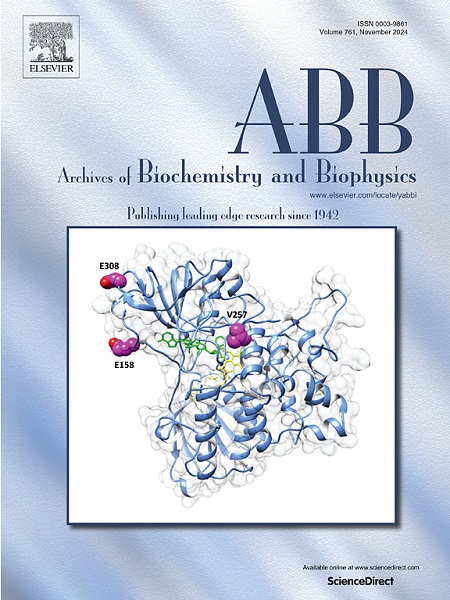结构和生化分析表明,奎宁酸能抑制莽草酸途径中的一个关键角色--DAHP 合成酶。
IF 3.8
3区 生物学
Q2 BIOCHEMISTRY & MOLECULAR BIOLOGY
引用次数: 0
摘要
动物体内不存在芳香族氨基酸生物合成所必需的莽草酸途径,因此该途径中的酶有望成为开发抗菌药物的目标。3-Deoxy-D-arabino-heptulosonate-7-phosphate synthase(DAHPS)催化第一个步骤,它是调节途径内流程的主要检查点,由其最终产物(Phe、Tyr 和 Trp)调节。此前,我们发现咖啡酸和奎宁酸的酯类绿原酸(CGA)是枯草芽孢杆菌 DAHPS 的抑制剂,这促使我们研究奎宁酸作为普罗维登夏藻 DAHPS(PaDAHPS)潜在抑制剂的可能性。在此,我们报告了苯丙氨酸敏感性 DAHPS 与苯丙氨酸(Phe)和奎宁酸(QA)复合物的晶体结构,其分辨率分别为 2.5 Å 和 2.68 Å。结构分析表明,QA 与 Phe 结合在相同的位点上,生物物理测定显示出相似的结合亲和力(QA 的 KD = 42 μM,Phe 的 KD = 32 μM)。体外抑制研究表明,QA 和 Phe 可抑制 PaDAHPS 的活性,其 appKi 值分别为 382 μM 和 132 μM。此外,QA 还能抑制多种细菌的生长,包括铜绿假单胞菌、白喉摩拉菌、普罗维登斯氏藻、金黄色葡萄球菌和大肠杆菌,最低抑菌浓度(MICs)为 2.5 至 5 毫克/毫升。这些研究结果表明,奎宁酸是一种很有前景的支架,可用于开发针对莽草酸途径的新型抗菌剂,为细菌感染提供潜在的治疗策略。本文章由计算机程序翻译,如有差异,请以英文原文为准。

Structural and biochemical analyses reveal quinic acid inhibits DAHP synthase a key player in shikimate pathway
The shikimate pathway, essential for aromatic amino acid biosynthesis, is absent in animals, making its enzymes promising targets for developing antimicrobials. 3-Deoxy-D-arabino-heptulosonate-7-phosphate synthase (DAHPS) catalyzes the first committed step, which serves as the primary checkpoint for regulating the flow within the pathway, regulated by its end products (Phe, Tyr and Trp). Previously, we identified chlorogenic acid (CGA), an ester of caffeic and quinic acid, as an inhibitor of DAHPS from Bacillus subtilis, prompting us to investigate quinic acid as a potential inhibitor of Providencia alcalifaciens DAHPS (PaDAHPS). Here, we report the crystal structures of phenylalanine-sensitive DAHPS from Providencia alcalifaciens in complex with phenylalanine (Phe) and quinic acid (QA) at resolutions of 2.5 Å and 2.68 Å, respectively. Structural analysis reveals that QA binds to the same site as Phe, with biophysical assays showing a similar binding affinity (KD = 42 μM for QA and KD = 32 μM for Phe). In vitro inhibition studies demonstrated that QA and Phe inhibit PaDAHPS activity, with appKi values of 382 μM and 132 μM, respectively. Additionally, QA inhibited the growth of several bacterial species, including Pseudomonas aeruginosa, Moraxella catarrhalis, Providencia alcalifaciens, Staphylococcus aureus, Escherichia coli with minimum inhibitory concentrations (MICs) ranging from 2.5 to 5 mg/ml. These findings identify quinic acid as a promising scaffold for developing novel antimicrobial agents targeting the shikimate pathway, providing potential therapeutic strategies for bacterial infections.
求助全文
通过发布文献求助,成功后即可免费获取论文全文。
去求助
来源期刊

Archives of biochemistry and biophysics
生物-生化与分子生物学
CiteScore
7.40
自引率
0.00%
发文量
245
审稿时长
26 days
期刊介绍:
Archives of Biochemistry and Biophysics publishes quality original articles and reviews in the developing areas of biochemistry and biophysics.
Research Areas Include:
• Enzyme and protein structure, function, regulation. Folding, turnover, and post-translational processing
• Biological oxidations, free radical reactions, redox signaling, oxygenases, P450 reactions
• Signal transduction, receptors, membrane transport, intracellular signals. Cellular and integrated metabolism.
 求助内容:
求助内容: 应助结果提醒方式:
应助结果提醒方式:


